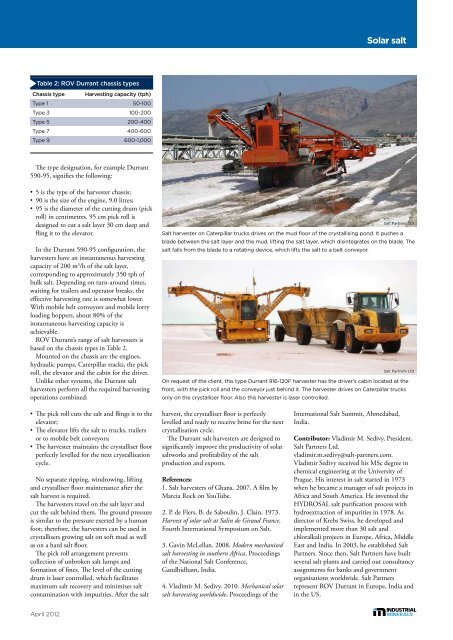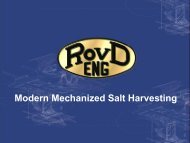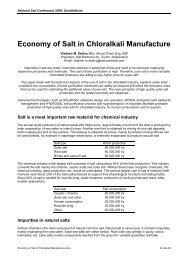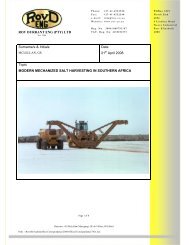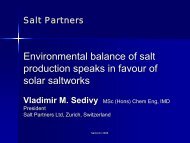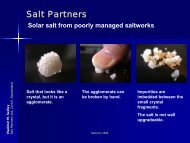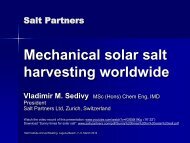Sunny times for solar salt
Sunny times for solar salt.pdf - ResearchGate
Sunny times for solar salt.pdf - ResearchGate
- No tags were found...
Create successful ePaper yourself
Turn your PDF publications into a flip-book with our unique Google optimized e-Paper software.
Solar <strong>salt</strong><br />
Table 2: ROV Durrant chassis types<br />
Chassis type Harvesting capacity (tph)<br />
Type 1 50-100<br />
Type 3 100-200<br />
Type 5 200-400<br />
Type 7 400-600<br />
Type 9 600-1,000<br />
The type designation, <strong>for</strong> example Durrant<br />
590-95, signifies the following:<br />
• 5 is the type of the harvester chassis;<br />
• 90 is the size of the engine, 9.0 litres;<br />
• 95 is the diameter of the cutting drum (pick<br />
roll) in centimetres. 95 cm pick roll is<br />
designed to cut a <strong>salt</strong> layer 30 cm deep and<br />
fling it to the elevator.<br />
In the Durrant 590-95 configuration, the<br />
harvesters have an instantaneous harvesting<br />
capacity of 200 m 3 /h of the <strong>salt</strong> layer,<br />
corresponding to approximately 350 tph of<br />
bulk <strong>salt</strong>. Depending on turn-around <strong>times</strong>,<br />
waiting <strong>for</strong> trailers and operator breaks, the<br />
effective harvesting rate is somewhat lower.<br />
With mobile belt conveyors and mobile lorry<br />
loading hoppers, about 80% of the<br />
instantaneous harvesting capacity is<br />
achievable.<br />
ROV Durrant’s range of <strong>salt</strong> harvesters is<br />
based on the chassis types in Table 2.<br />
Mounted on the chassis are the engines,<br />
hydraulic pumps, Caterpillar tracks, the pick<br />
roll, the elevator and the cabin <strong>for</strong> the driver.<br />
Unlike other systems, the Durrant <strong>salt</strong><br />
harvesters per<strong>for</strong>m all the required harvesting<br />
operations combined:<br />
Salt Partners Ltd<br />
Salt harvester on Caterpillar trucks drives on the mud floor of the crystallising pond. It pushes a<br />
blade between the <strong>salt</strong> layer and the mud, lifting the <strong>salt</strong> layer, which disintegrates on the blade. The<br />
<strong>salt</strong> falls from the blade to a rotating device, which lifts the <strong>salt</strong> to a belt conveyor.<br />
Salt Partners Ltd<br />
On request of the client, this type Durrant 916‐120F harvester has the driver’s cabin located at the<br />
front, with the pick roll and the conveyor just behind it. The harvester drives on Caterpillar trucks<br />
only on the crystalliser floor. Also this harvester is laser controlled.<br />
• The pick roll cuts the <strong>salt</strong> and flings it to the<br />
elevator;<br />
• The elevator lifts the <strong>salt</strong> to trucks, trailers<br />
or to mobile belt conveyors;<br />
• The harvester maintains the crystalliser floor<br />
perfectly levelled <strong>for</strong> the next crystallisation<br />
cycle.<br />
No separate ripping, windrowing, lifting<br />
and crystalliser floor maintenance after the<br />
<strong>salt</strong> harvest is required.<br />
The harvesters travel on the <strong>salt</strong> layer and<br />
cut the <strong>salt</strong> behind them. The ground pressure<br />
is similar to the pressure exerted by a human<br />
foot; there<strong>for</strong>e, the harvesters can be used in<br />
crystallisers growing <strong>salt</strong> on soft mud as well<br />
as on a hard <strong>salt</strong> floor.<br />
The pick roll arrangement prevents<br />
collection of unbroken <strong>salt</strong> lumps and<br />
<strong>for</strong>mation of fines. The level of the cutting<br />
drum is laser controlled, which facilitates<br />
maximum <strong>salt</strong> recovery and minimises <strong>salt</strong><br />
contamination with impurities. After the <strong>salt</strong><br />
harvest, the crystalliser floor is perfectly<br />
levelled and ready to receive brine <strong>for</strong> the next<br />
crystallisation cycle.<br />
The Durrant <strong>salt</strong> harvesters are designed to<br />
significantly improve the productivity of <strong>solar</strong><br />
<strong>salt</strong>works and profitability of the <strong>salt</strong><br />
production and exports.<br />
References:<br />
1. Salt harvesters of Ghana. 2007. A film by<br />
Marcia Rock on YouTube.<br />
2. P. de Flers, B. de Saboulin, J. Clain. 1973.<br />
Harvest of <strong>solar</strong> <strong>salt</strong> at Salin de Giraud France,<br />
Fourth International Symposium on Salt.<br />
3. Gavin McLellan. 2008. Modern mechanised<br />
<strong>salt</strong> harvesting in southern Africa, Proceedings<br />
of the National Salt Conference,<br />
Gandhidham, India.<br />
4. Vladimir M. Sedivy. 2010. Mechanical <strong>solar</strong><br />
<strong>salt</strong> harvesting worldwide, Proceedings of the<br />
International Salt Summit, Ahmedabad,<br />
India.<br />
Contributor: Vladimir M. Sedivy, President,<br />
Salt Partners Ltd.<br />
vladimir.m.sedivy@<strong>salt</strong>-partners.com.<br />
Vladimir Sedivy received his MSc degree in<br />
chemical engineering at the University of<br />
Prague. His interest in <strong>salt</strong> started in 1973<br />
when he became a manager of <strong>salt</strong> projects in<br />
Africa and South America. He invented the<br />
HYDROSAL <strong>salt</strong> purification process with<br />
hydroextraction of impurities in 1978. As<br />
director of Krebs Swiss, he developed and<br />
implemented more than 30 <strong>salt</strong> and<br />
chloralkali projects in Europe, Africa, Middle<br />
East and India. In 2003, he established Salt<br />
Partners. Since then, Salt Partners have built<br />
several <strong>salt</strong> plants and carried out consultancy<br />
assignments <strong>for</strong> banks and government<br />
organisations worldwide. Salt Partners<br />
represent ROV Durrant in Europe, India and<br />
in the US.<br />
April 2012


